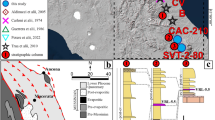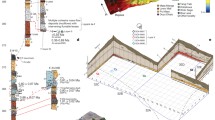Abstract
Dickinsonia tenuis, an important Ediacaran element, reported from the Maihar Sandstone by Retallack et al. (2021) was re-examined in the field to ascertain the biogenicity of the purported fossils. Field observations, outcrop features, and laboratory analyses (XRD, Raman Spectroscopy) do not support the biogenicity and syngenecity of reported objects. Based on this discovery, the inferences drawn about the age of the Maihar Sandstone and the palaeogeographic position of India are therefore considered invalid. Indian Dickinsonia specimen described by Retallack et al. (2021) is a left-over impression of a fallen beehive which is further proved by the detailed Raman Spectroscopy and X-Ray Diffraction (XRD) analyses.
Similar content being viewed by others
References
Allwood, A.C., Rosing, M.T, Flannery, D.T., Hurowitz, J.A., and Heirwegh, C.M. (2018) Reassessing evidence of life in 3,700-million-year old rocks of Greenland. Nature, v.563, pp.241–244.
Awramik, S.M., and Grey, K. (2005) Stromatolites: Biogenecity, biosignatures, and bioconfusion. Proc. SPIE5906, pp.1–9.
Awramik, S.M., Schopf, J.W. and Walter, M.R. (1983) Filamentous fossil bacteria from the Archean of Western Australia. Precambrian Res., v.20, pp.357–374.
Azmi, R.J. (1998) Discovery of Lower Cambrian small shelly fossils and brachiopods from the Lower Vindhyan of Son Valley, Central India. Jour. Geol. Soc. India, v.52, pp.381–389.
Bengtson, S., Belivanova, V., Rasmussen, B. and Whitehouse, M.J. (2009) The controversial “Cambrian” fossils of the Vindhyan are real but more than a billion years older. P.roc Natl. Acad. Sci. USA, v.106(19), pp.7729–7734.
Bhatt, D.K., Singh, G., Gupta, S., Soni, M.K., Moitra, A.K., Das, D.P. and De, C. (1999) Fossil report from Semri Group, lower Vindhyan. Jour. Geol. Soc. India, v.53(6), pp.717–723.
Bickford, M.E. and Basu, A. (2021) “Towards resolving the ‘jigsaw puzzle’ and age-fossil inconsistency within east Gondwana”: A comment. Precambrian Res., v.352, 105881.
Brasier, M. (1999) Discovery of Lower Cambrian small shelly fossils and brachiopods from the Lower Vindhyan of Son Valley, Central India — discussion. Jour. Geol. Soc. India, v.53, pp.727–730
Brasier, M.D., Antcliffe, J., Saunders, M., and Wacey, D. (2015) Changing the picture of Earth’s earliest fossils (3.5–1.9 Ga) with new approaches and new discoveries. Proc. Nat. Aca. Sci., v.112(16), pp.4859–4864.
Brasier, M.D., Green, O.R., Jephcoat, A.P., Kleppe, A.K., Van Kranendonk, M.J., Lindsay, J.F., Steele, A., and Grassineau, N.V. (2002) Questioning the evidence of Earth’s oldest fossils. Nature, v.416, pp.76–81.
Bucio, A., Moreno Tovar, R., Bucio, L., Espinosa Dávila, J. and Anguebes Franceschi, F. (2021) Characterization of Beeswax, Candelilla Wax and Paraffin Wax for Coating Cheeses. Coatings, v.11, 261.
Buick, R. (1984) Carbonaceous filaments from North Pole, Western Australia: are they fossil bacteria in Archaean stromatolites? Precambrian Res., v.24, pp.157–172.
Buick, R., Dunlop, J.S.R., and Groves, D.I. (1981) Stromatolite recognition in ancient rocks: an appraisal of irregular laminated structures in an early Archean chert—barite unit from North Pole, Western Australia. Alcheringa, v.5, pp.161–181.
Droser, M.L., Evans, S.D., Tarhan, L.G., Surprenant, R.L., Hughes, I.V., Hughes, E.B. and Gehling, J.G. (2022) What happens between depositional events, stays between depositional events: the significance of organic mat surfaces in the capture of Ediacara communities and the sedimentary rocks that preserve them. Front. Earth Sci., v.10, 826353.
Evans, S.D., Droser, M.L. and Gehling, J.G. (2017) Highly regulated growth and development of the Ediacara macrofossil Dickinsonia costata. PLoS ONE, v.12, e0176874.
Evans, S.D., Gehling, J.G., and Droser, M.L. (2019) Slime travelers: Early evidence of animal mobility and feeding in an organic mat world. Geobiology, v.17, pp.490–509.
Fratini, F., Cilia, G., Turchi, B. and Felicioli, A. (2016) Beeswax: A mini review of its antimicrobial activity and its application in medicine. Asian Pac. Jour. Trop. Med., v.9, pp.839–843
García-Ruiz, J.M., Hyde, S.T., Carnerup, A.M., Christy, A.G., Van Kranendonk, M.J., and Welham, N.J. (2003) Self-assembled silica carbonate structures and detection of ancient microfossils. Science, v.302, pp.1194–1197.
Gehling, J.G. (1999) Microbial Mats in Terminal Proterozoic Siliciclastics: Ediacaran Death Masks. Palaios, v.14, pp.40–57.
Grotzinger, J.P., and Rothman, D.H. (1996) An abiotic model for stromatolite morphogenesis. Nature, v.383, pp.423–425.
Ivantsov, A., and Zakrevskaya, M. (2022) Dickinsonia costata of the Winter Mountains: Features of morphology and ontogenesis. Precambrian Res., v.379, 106788.
Jenkins, R.J.F. (1992) Functional and ecological aspects of Ediacaran assemblages. In: Lipps, J.H. & Signor, P.W. (Eds), Origin and early evolution of the Metazoa. New York: Plenum Press, pp.131–76.
Jokhan, Ram, Shukla, S.N., Parmanik, A.G., Varma, B.K., Gyanesh, Chandra and Murty, M.S.N. (1996) Recent investigations in the Vindhyan basin: Implications for the basin tectonics. In Bhattacharya, A. (Ed.), Recent advances in Vindhyan geology. Mem. Geol. Soc. India, v.36, pp.267–286.
Kerr, R.A. (1999) Earliest animals growing younger? Science, v.284, p.412.
Knoll, A.H., Bergmann, K.D., and Strauss, J.V. (2016) Life: the first two billion years. Philos. Trans. Roy. Soc. B., v.371, pp.1–13.
Krishnan, M.S. and Swaminath, J. (1959) The Great Vindhyan Basin of northern India. Jour. Geol. Soc. India, v.1, pp.10–36.
Kumar, S. and Pandey, S.K. (2008) Arumberia and associated fossils from the Neoproterozoic Maihar Sandstone, Vindhyan Supergroup, Central India. Jour. Palaeontol. Soc. India, v.53, pp.83–97.
Lan, Z., Zhang, S., Li, X.H., Pandey, S.K., Sharma, M., Shukla, Y., Ahmad, S., Sarkar, S. and Zhai, M. (2020) Towards resolving the ‘jigsaw puzzle’ and age-fossil inconsistency within East Gondwana. Precambrian Res., v.345, 105775.
Lan, Z., Zhang, S., Li, X.H., Pandey, S.K., Sharma, M., Shukla, Y., Ahmad, S., Sarkar, S. and Zhai, M. (2021) Reply to “Towards resolving the ‘jigsaw puzzle’ and age-fossil inconsistency within east Gondwana: A comment by Bickford & Basu (2021a). Precambrian Res., v.352, 105881.
Lowe, D.R. (1994) Abiological origin of described stromatolites older than 3.2 Ga. Geology, v.22, pp.387–390.
Malone, S.J., Meert, J.G., Banerjee, D.M., Pandit, M.K., Tamrat, J., Kamenov, G.D., Pradhan, V.R. and Sohl, L.I. (2008) Paleomagnetism and detrital zircon geochemistry of the Upper Vindhyan sequence of Son Valley and Rajasthan: a ca.1000 Ma closure age for the Purana Basin. Precambrian Res., v.164, pp.137–159.
Mathpal, Y. (1984) Newly discovered rock paintings in central India showing honey collection. Bee World, v.65(3), pp.121–126.
Mathur, S.M. (1987) Geochronology and biostratigraphy of the Vindhyan Supergroup. Geol. Surv. India Spec. Pub., v.11, pp.23–44.
McKenzie, N.R., Hughes, N.C., Myrow, P.M., Xiao, S. and Sharma, M. (2011) Correlation of Precambrian-Cambrian sedimentary successions across northern India and the utility of isotopic signatures of Himalayan lithotectonic zones. Earth Planet. Sci. Lett., v.312, pp.471–483.
McMahon, W.J., Davies, N.S., Liu, A.G. and Went, D.J. (2022) Enigma variations: characteristics and likely origin of the problematic surface texture Arumberia, as recognized from an exceptional bedding plane exposure and the global record. Geol. Mag., v.159, pp.1–20.
Meert, J.G., Pandit, M.K., Kwafo, S. and Singha, A. (2023) Stinging News: ‘Dickinsonia’ discovered in the Upper Vindhyan of India not worth the buzz. Gondwana Res. doi:https://doi.org/10.1016/j.gr.2023.01.003
Nutman, A.P., Bennett, V.C., Friend, C.R.L., Van Kranendonk, M.J., and Chivas, A.R. (2016) Rapid emergence of life shown by discovery of 3,700-million-year-old microbial structures. Nature, v.537, pp.525–538.
Pang, M., Shi, Z., Lei, Z., Ge, Y., Jiang, S. and Cao, L. (2020) Structure and thermal properties of beeswax-based oleogels with different types of vegetable oil. Grasas Aceites, v.71(4), e380.
Rai, V. and Gautam, R. (1999) Evaluating evidence of ancient animals. Science, v.284, p.235.
Retallack, G.J., Matthews, N.A., Master, S., Khangar, R.G. and Khan, M. (2021) Dickinsonia discovered in India and late Ediacaran biogeography. Gondwana Res., 90, pp.165–170.
Schopf, J.W., Tripathi, A.B. and Kudryavtsev, A.B. (2006) Three-dimensional Confocal Optical Imagery of Precambrian microscopic organisms. Astrobiology, v.6(1), pp.1–16.
Seilacher, A., Bose, P.K. and Pfluger, F. (1998) Triploblastic animals more than 1 billion years ago: trace fossil evidence from India. Science, v.282, pp.80–83.
Sharma, M., Pandey, S.K. and Kumar, S. (2020) Vindhyan Basin, Son valley area, Central India. A Field trip guide. 36th International Geological Congress (IGC), 176p.
Sharma, M., Shukla, M. and Venkatachala, B.S. (1992) Metaphyte and Metazoan fossils from Precambrian sediments of India a critique. Palaeobotanist, v.40, pp.8–51.
Soni, M.K., Chakraborty, S. and Jain, V.K. (1987) Vindhyan Supergroup; A review. Mem. Geol. Soc. India, v.6, pp.87–138.
Srivastava, B.N., Rana, M.S. and Verma, N.K. (1983) Geology and Hydrocarbon Products of the Vindhyan Basin. In: Bhandari, L.L., Venkatachala, B.S., Kumar, R., Swamy, S.N., Garga, P., Srivastava, D.C. (Eds.), Petroliferous basins of India. Petroleum Asia Jour., Dehradun, India, pp.179–189.
Acknowledgments
The authors are thankful to the Director, Birbal Sahni Institute of Palaeosciences, for extending the facilities to carry out the investigations and for permission to publish this work (RDCC/2022-23/69). We are highly obliged to the Archaeological Survey of India, New Delhi (Dr. K. Lourdusamy, Director, Exploration, and Excavation Section), to provide permission to examine the Bhimbetka Shelter Caves to study these (?)fossils. We are grateful to Dr. Manoj Kumar Kurmi, Superintending Archaeologist, ASI, Bhopal Circle for extending help during our visit to collect samples. Ground staff of ASI, Bhopal circle, and security personnel M/s Krishna Kumar, Pawan Singh, Ram Bilas, Madan Lal Kundre, and Radhey Shyam are also acknowledged. We thank anonymous reviewer for constructive review.
Author information
Authors and Affiliations
Corresponding authors
Electronic Supplementary Material
Rights and permissions
About this article
Cite this article
Pandey, S.K., Ahmad, S. & Sharma, M. Dickinsonia tenuis reported by Retallack et al. 2021 is not a fossil, instead an impression of an extant ‘fallen beehive’. J Geol Soc India 99, 311–316 (2023). https://doi.org/10.1007/s12594-023-2312-2
Received:
Accepted:
Published:
Issue Date:
DOI: https://doi.org/10.1007/s12594-023-2312-2




